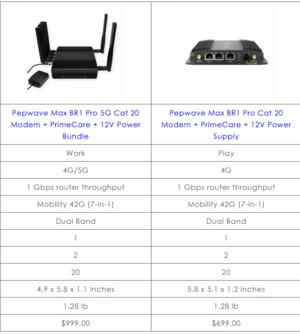marc2912
RVF Supporter
- Joined
- Aug 12, 2021
- Messages
- 264
- Location
- New York
- RV Year
- 2015
- RV Make
- Newmar
- RV Model
- Dutch Star 4312
- RV Length
- 43'
- Chassis
- Freightliner
- Engine
- Cummins 450HP
- TOW/TOAD
- 2022 Jeep Unlimited Sport S w/ Air Force One and Blue Ox
Food for thought for anyone else assessing Peplink's lineup to get WAN bonding:
With the release of firmware 8.3 the Balance 20X has become an amazing device for the money - unfortunately most online literature hasn't been updated to reflect the changes.
TL;DR: The 20x is now on the mobile OS, for under $600, and has the ability to expand to 7 WAN inputs!
Some highlights:
Basically you can build it out to have similar functionality as the $2900 BR2 - but only buy the pieces you need.
- It has been moved to the mobile interface - so its UI is now the same as the Max/BR devices.
- Cellular: It comes with one cellular modem (opt for the cat 7 - not the cheaper cat 4) and has a slot for a 2nd modem AND has a USB port for a 3rd modem that is plug & play in the UI so it works as if it were internal.
- Primecare is Level 1 - so it is under $50 per year - and that includes 500mb of speed fusion. Additional TB's of speed fusion are only $40.
- With Primecare it now includes a virtual Wan license so you can have TWO ethernet Wan devices.
- With Primecare it now includes Wifi as Wan
- Runs easily on DC
Food for thought.
cheers,
Edward in Colorado
p.s. There is rumor of a Balance 20x Pro in the works.
Thanks for the update @sleepwalker
Def food for thoughts on those looking to build out.













